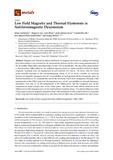Mostrar el registro sencillo del ítem
Low field magnetic and thermal hysteresis in antiferromagnetic dysprosium
| dc.creator | Liubimova, Iuliia | es_ES |
| dc.creator | Corró Moyá, Miguel | es_ES |
| dc.creator | Torrens Serra, Joan | es_ES |
| dc.creator | Recarte Callado, Vicente | es_ES |
| dc.creator | Pérez de Landazábal Berganzo, José Ignacio | es_ES |
| dc.creator | Kustov, Sergey | es_ES |
| dc.date.accessioned | 2017-11-15T09:28:42Z | |
| dc.date.available | 2017-11-15T09:28:42Z | |
| dc.date.issued | 2017 | |
| dc.identifier.issn | 2075-4701 | |
| dc.identifier.uri | https://hdl.handle.net/2454/26178 | |
| dc.description.abstract | Magnetic and thermal hysteresis (difference in magnetic properties on cooling and heating) have been studied in polycrystalline Dy (dysprosium) between 80 and 250 K using measurements of the reversible Villari effect and alternating current (AC) susceptibility. We argue that measurement of the reversible Villari effect in the antiferromagnetic phase is a more sensitive method to detect magnetic hysteresis than the registration of conventional B(H) loops. We found that the Villari point, recently reported in the antiferromagnetic phase of Dy at 166 K, controls the essential features of magnetic hysteresis and AC susceptibility on heating from the ferromagnetic state: (i) thermal hysteresis in AC susceptibility and in the reversible Villari effect disappears abruptly at the temperature of the Villari point; (ii) the imaginary part of AC susceptibility is strongly frequency dependent, but only up to the temperature of the Villari point; (iii) the imaginary part of the susceptibility drops sharply also at the Villari point. We attribute these effects observed at the Villari point to the disappearance of the residual ferromagnetic phase. The strong influence of the Villari point on several magnetic properties allows this temperature to be ranked almost as important as the Curie and Néel temperatures in Dy and likely also for other rare earth elements and their alloys. | en |
| dc.description.sponsorship | This work was supported by the Spanish Ministerio de Economía y Competitividad, project MAT2014-56116-C04-01-R and by the Government of the Russian Federation (Grant 074-U01) through the ITMO Fellowship and Professorship Program. | en |
| dc.format.extent | 12 p. | |
| dc.format.mimetype | application/pdf | en |
| dc.language.iso | eng | en |
| dc.publisher | MDPI | en |
| dc.relation.ispartof | Metals 2017, 7(6), 215 | en |
| dc.rights | © 2017 by the authors. Licensee MDPI, Basel, Switzerland. This article is an open access article distributed under the terms and conditions of the Creative Commons Attribution (CC BY) license. | en |
| dc.rights.uri | https://creativecommons.org/licenses/by/4.0/ | |
| dc.subject | Rare earth metals | en |
| dc.subject | Magnetostriction | en |
| dc.subject | Antiferromagnetism | en |
| dc.subject | Villari effect | en |
| dc.title | Low field magnetic and thermal hysteresis in antiferromagnetic dysprosium | en |
| dc.type | Artículo / Artikulua | es |
| dc.type | info:eu-repo/semantics/article | en |
| dc.contributor.department | Física | es_ES |
| dc.contributor.department | Fisika | eu |
| dc.rights.accessRights | Acceso abierto / Sarbide irekia | es |
| dc.rights.accessRights | info:eu-repo/semantics/openAccess | en |
| dc.identifier.doi | 10.3390/met7060215 | |
| dc.relation.projectID | info:eu-repo/grantAgreement/MINECO//MAT2014-56116-C4-1-R/ES/ | en |
| dc.relation.publisherversion | https://dx.doi.org/10.3390/met7060215 | |
| dc.type.version | Versión publicada / Argitaratu den bertsioa | es |
| dc.type.version | info:eu-repo/semantics/publishedVersion | en |



